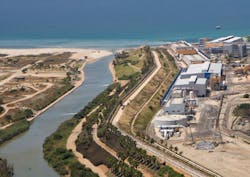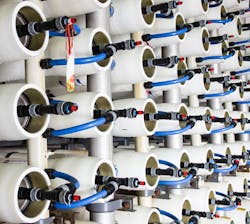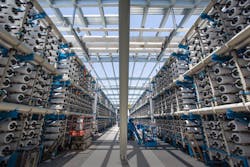A variety of chemicals are used to help water treatment and desalination operations run efficiently and stop fouling and scaling. So, how big is the chemical treatment market? What challenges do companies operating in this sector currently face? And what impact are improved membranes that require less cleaning having on the chemical business?
By Andrew Williams
A wide range of chemicals are used extensively in the desalination and water treatment business. Substances used typically falling into one of two main groups.
The first group, known as ‘online’ chemicals, includes coagulants, flocculants, chlorination and de-chlorination agents and biocides. The second group, often called ‘offline’ chemicals, includes a large number of somewhat stronger chemicals that can be used for a variety of purposes such as dissolving the fouling that attaches to filtration membranes during operation.
Using the latest available data, IHS Chemical estimates that, between 2010 and 2015, the overall global consumption of water treatment chemicals grew by 3.2% a year to around $12.4 billion. The company also predicts that this impressive growth will total around 6.1% each year in China, with consumption in other “leading major markets” also forecast to grow - to the tune of 5% a year through 2015 in South America, 2.9% a year in North America and 2.2% a year in Europe.
The desalination chemical treatment market for scale inhibitors, biocides and cleaners is approximately $600 million, according to Richard Barwell, VP MENA at chemical company BWA Water Additives.
The desalination process is divided into thermal and membrane applications by type of plant and is mostly used in the Middle East, North Africa, Southern Europe, the US, Southeast Asia and Australia.
Over 70% of thermal desalination production is used in drinking water and less than 20% used for industrial applications.
“The thermal market is growing at a rate of 2.5 CAGR (compound annual growth rate), with the Middle East accounting for 90% of the market,” says Barwell. “Membrane desalination also has a very large presence in the US - at over seven million cubic meters a day of production - with Saudi Arabia next at around four million cubic meters a day. The membrane market is growing around 9% CAGR with Seawater Reverse Osmosis growing the fastest.”
Destressing Stressed Waters
According to Matt Armstrong from chemical manufacturer Genesys International, one of the main challenges currently facing the sector is that feed water sources are changing. This is coupled with the fact that water sources are “under more pressure” and environmental legislation is “driving projects to save and recover a greater percentage of water”. As a result, he says, “operators are having to run membrane systems on poorer quality feed water at higher recovery rates”.
“Water reuse is also becoming more common. This involves reuse of wastewater, which is often high in organics, biofilm potential and other possible membrane foulants, and again causes issues for the membrane operator,” he says.
Armstrong also reveals that the company is becoming more involved in areas containing what he describes as “stressed waters” with high scaling and high metal content in remote areas. This is as well as in applications of water reuse where an understanding of feed water and operating characteristics is “vital”. In facing up to the challenges inherent in such operations, he points out that Genesys has established an autopsy facility in Spain and an R&D laboratory in the UK, which were developed specifically to “understand and find solutions to the issues facing operators of membrane plants”.
“Membrane cleaners are also currently a significant focus in terms of R&D budget and we have recently developed and patented a unique membrane cleaning microbubble system, designed for spiral wound RO membranes,” he adds.
Elsewhere, David Martin, VP, marketing, water & process services, Europe and MENA at Ecolab, agrees that water scarcity is a major challenge facing operators in the sector - and highlights the fact that customers are becoming more global and looking for solutions that can be “deployed consistently around the world”.
“Environmental regulations are also becoming tighter so companies need to be ahead of the legislation. We overcome this particular challenge by investing in research and development in order to ensure that what we are offering is compliant with the ever-evolving environmental regulations,” he says.
Meanwhile, Barwell points out that, in membrane desalination, the treatment of water sources with “less than desirable characteristics” presents a challenge to companies in providing “the right scale, fouling and microbial control”.
With reverse osmosis plants “being pushed to treat the harshest of waters” he also says that there is now a drive to produce environmentally friendly solutions. “Membranes are also being developed to work at higher efficiencies with tighter design capacities,” he says. “The control of chemistries and performance monitoring are essential to maintaining efficiencies and reducing operational cost.”
Environmental Footprint
Looking ahead, Barwell says that in the thermal desalination space there will be a continual push to develop higher efficiency distillation plants, which he argues puts “great onus on providing the industry with antiscalant chemistries to operate at higher temperatures”.
“With this in mind when developing the next molecular solutions, we must understand the need to minimise chemical usage whilst maintaining process efficiency and asset integrity. One of the challenges the industry faces is maintaining a water supply though minimal plant outages through the highest possible conversion efficiencies,” he says.
“We have also developed sophisticated software projection tools and new chemistries to ensure that all water sources can be controlled in terms of membrane scaling, fouling and biological growth to give reassurance to end users who work with difficult water,” he adds.
In the near future, Barwell believes that key developments in the chemical treatment of desalination plants will fall into one of three categories: the provision of solutions to reduce customer’s environmental footprints, the improvement of system monitoring & control, and the provision of the next generation of antiscalants and biocides that not only improve performance, but perform more safely.
“The main opportunities will be in the rapidly expanding membrane sector, where chemicals and equipment will be a key focus for years to come, especially in the Middle East, South East Asia and Sub-Saharan Africa,” he adds.
Beating Biofilm
Meanwhile, Armstrong singles out the need to reduce and eliminate biofilm as a key driver of change and innovation in the membrane chemical industry. In view of the fact that the polyamide structure and the use of permeates limits the potential use of biocide in many membrane applications, he says that biofilm control will always be a key factor in R&D for many chemical companies.
“Many people outside of the industry have a closed view of chemicals and see all chemicals as detrimental to the environment. It is easy to ignore the fact that a correctly applied antiscalant and good cleaning regime can save significant amounts of water and energy during operation. Environmental factors in chemical use and water and energy savings will also be key to future developments,” he adds.
Andrew Williams is a freelance correspondent for WWi magazine. For more information on the article, please email: [email protected]
Impact of Improved Membrane Filtration Technology
For some, the use of chemicals in water treatment is problematic for a number of reasons, including reagent production, health risks and CO2 production, as well as for the potential risks associated with transportation, storage, dosing and sludge treatment. Such environmental considerations mean that many companies in the industry are now working towards the termination of the use of chemical processes, and their replacement with natural biological and physical processes.
One such company is IDE Technologies, which has recently developed a novel direct osmosis high salinity (DOHS) membrane cleaning system. According to Boris Liberman, VP and CTO for membrane technologies at IDE Technologies, the system eliminates chemical use in membrane cleaning, increases process recovery ration and prolongs membrane life - and is capable of removing the fouling layer quickly while the unit is still operating. It does so by injecting slug of salt solution into the feed water, where it passes through in situ pressure vessels. Where the salt water slug is in contact with the membranes, direct osmosis (DO) occurs - and water molecules pass from the permeate side to the feed side of the membrane - helping to lift the fouling layer off the membranes, and direct it out of the system within the concentrate stream.
“The main advantage of the DOHS system is the possibility of avoiding the implementation of any chemicals in the pre-treatment and RO parts of the plant, other than the use of antiscalant in brackish water RO applications. This is achieved by replacing chemicals with physical and natural biological processes,” says Liberman.
“The advantage of online Osmotic membrane cleaning will be extremely visible with the new generation of membranes entering the market, such as graphine and nanosystems. The new membranes will operate with five to eight times higher flux, meaning that, with the same quality pre-treatment, the new generation of membranes will be fouled five to eight times faster. Only online osmotic cleaning, performed in a few seconds, without stopping the RO process, can solve this contradiction between high flux operation and high rate of fouling,” he adds.
More Water & WasteWater International Archives Issue Articles






